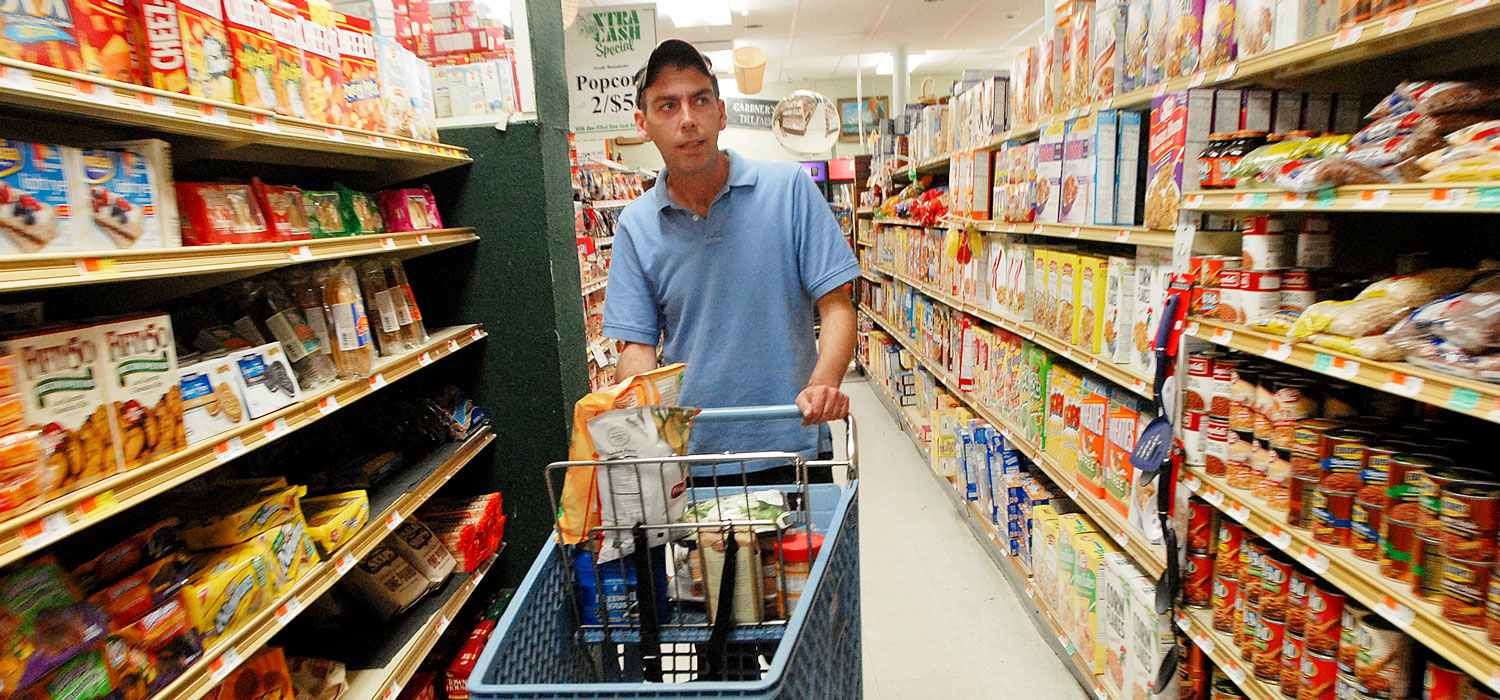
<p>Keven Gillette of Portland makes his way down the aisle at Paul's Food Center in Portland Monday, August 11, 2008. Gillette, who uses food stamps, tries to keep his shopping to under $60. Photo by Shawn Patrick Ouellette/Portland Press Herald via Getty Images.</p>
President Trump’s budget proposal released last week aims to cut spending on the Supplemental Nutrition Assistance Program (SNAP)—the nation’s primary federal nutrition program—by more than $4.6 billion in 2018, or roughly 6.5 percent. Over the entire 10-year budget window, the president’s budget projects total savings to reach almost $191 billion.
The budget is short on details about how the president will cut SNAP spending by that margin, but it lists four items that are expected to achieve these savings. We examine each of these strategies, starting with what we believe could lead to the most significant changes.
1. “Rebalance the state-federal partnership.”
Although SNAP is administered by the states, which have flexibility in modifying eligibility criteria, the federal government pays the full cost of monthly benefits for anyone who is eligible. The budget proposes changing this long-standing approach by requiring states to shoulder some of the benefit costs beginning in 2020, with an average match of 10 percent and increasing to an average of 25 percent by 2023.
With tight budgets, states may be unable or unwilling to absorb new expenditures, which could be significant. Take Virginia. In fiscal year 2015, more than 860,000 Virginians participated in SNAP every month on average. In that year, the federal government paid $97.5 million in administrative costs and $1.23 billion in benefits, while Virginia paid $99.5 million in administrative costs. A 10 percent additional cost-share for Virginia’s benefits in that year would have added another $123 million to the state’s program obligations, an increase of 224 percent.
Unfortunately, several factors are creating new pressures on both state revenue and expenditures. As the 21st-century economy continues to evolve, more online sales and more “gig” workers can push tax revenue down. As the population ages, health care costs will rise and fewer working-age adults can fill jobs, which can lead to a lower revenue pool.
This proposed shift in paying for SNAP will likely pressure states to reduce SNAP participation through reducing eligibility, employing more complex administrative procedures, or implementing more stringent work requirements. Regardless of the response, the risk of reducing access to benefits falls heavily on the most vulnerable: 75 percent of SNAP households include at least one child, elderly adult, or disabled person.
2. “Require able-bodied adults to work.”
This line in the budget proposal may refer to able-bodied adults without dependents, or ABAWDs. These are 18- to 49-year-olds who do not have dependents and are not disabled. They are already limited to three months of SNAP participation within a 36-month period unless they meet special work requirements or the requirements are waived, such as in periods of high unemployment.
Given that ABAWDs do not represent most SNAP households (in fiscal year 2015, 19 percent of SNAP households had at least one member who was between 18 and 49, childless, and not disabled, the main criteria for ABAWD status) and that many of them cycle in and out of work, it is unlikely that the dramatic savings envisioned could be squeezed from this group alone.
ABAWDs are a vulnerable group. According to research from the Center of Budget and Policy Priorities, ABAWDs’ incomes average 29 percent of the federal poverty level when the value of SNAP benefits is included, or about $3,400 a year for a single person in 2016. Only 46 percent of this group live in households with any income while receiving SNAP benefits.
3. “Target benefits to the neediest households.”
Again, it is unclear what the administration intends with this strategy because SNAP already supports needy households. In 2015, 42 percent of SNAP households had gross monthly income less than or equal to 50 percent of the federal poverty level, and those households received 57 percent of all benefits. And most SNAP participants are children, elderly, or disabled.
4. “Close eligibility loopholes.”
Some SNAP beneficiaries do not qualify for SNAP benefits, but there are likely few.
States calculate their payment error rates—the share of households that received an incorrect payment (i.e., the payment was inaccurate, not necessarily too high or too low)—every year. Errors can result from various sources. The state agency can enter the data by mistake or the household could report incorrect information. In fiscal year 2015, these error rates averaged 3.66 percent, ranging from 0.42 percent in Florida to 7.61 percent in Nevada.
SNAP helps lift Americans out of poverty
Research shows that SNAP helps lift people out of poverty and reduces food insecurity. Research has shown that an additional 3.9 million people would have fallen into poverty in 2011 without SNAP benefits.
SNAP participation may reduce childhood food insecurity as much as 12.8 percent. This assistance provided by SNAP is critical, as food insecurity can interfere with childhood development and increases the likelihood of poor health outcomes in both children and adults. Failing to address food insecurity in a focused, energetic manner puts our future workforce and health as a nation at risk, and we already have some of the worst health outcomes among high-income countries.
The president’s budget threatens to slash the benefits provided by this important program. The details are light, but the message is clear. People who receive SNAP benefits are facing significant cuts, and states that provide such assistance are going to face even greater budget constraints.
Let’s build a future where everyone, everywhere has the opportunity and power to thrive
Urban is more determined than ever to partner with changemakers to unlock opportunities that give people across the country a fair shot at reaching their fullest potential. Invest in Urban to power this type of work.